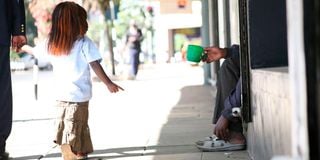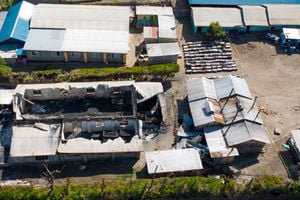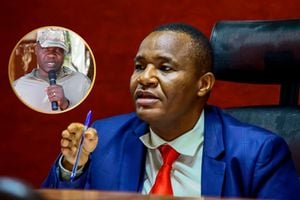How to Tackle extreme poverty in Kenya

A little girl walks past a partially beggar on the streets of Nairobi.
What you need to know:
- The World Bank has defined extreme poverty to mean persons living on less than $1.9 per day (Sh245).
- Kenya’s poverty rate is 38.6 per cent, according to latest Kenya National Bureau of Statistics data.
Poverty is a condition in which an individual lacks money to meet certain standard of life. Extreme poverty is lacking money to meet basic essentials of life like food, clothing and shelter.
Relative poverty entails inability to meet standards of living enjoyed by others within a similar setting.
This article concerns itself with extreme poverty. The World Bank has defined extreme poverty to mean persons living on less than $1.9 per day (Sh245). Governments employ different strategies to combat poverty.
It appears governments have to set up specific measures to combat poverty, otherwise individuals or markets cannot on their own achieve poverty reduction.
The anti-poverty measures differ from country to country, but there is a lot of cross-border referencing to enable a country achieve best practices.
Kenya’s poverty rate is 38.6 per cent, according to latest Kenya National Bureau of Statistics data. Assuming the Kenyan population is 50 million, poverty rate translates to 19 million individuals.
What are the possible measures to help these 19 million individuals overcome poverty in Kenya?
The first obvious measure would be to think of ways to boost their incomes. But how?
Some economists have argued governments should not really think so hard on the subject. Just pump in the cash needed to make the poor cross the poverty line directly into people's pockets — either as a cash transfer or universal basic income.
Boost agricultural earnings
If Onyango needs Sh244 daily to be classified as non-poor, just give him the money. Stop thinking about complex ideas on getting Onyango a job or creating conditions for job creating industries.
These economists argue the so-called "job creating measures" take time to mature and create good jobs whereas people are suffering now. Further, they argue, some long-term job creating measures are inefficient and plagued by corruption.
With automation, these economists say, people will lose their jobs but few excel. It is only moral for the successful few to share a portion of their profits as universal unconditional basic income. Kenya incidentally is experimenting this idea through cash transfers to the elderly.
The problem with this approach is the cost. The government needs Sh1.7 trillion per annum if it decided to directly send Sh244 to 19 million poor Kenyans. Kenya collected Sh2.4 trillion last financial year. If Sh1.7 trillion was sent directly to poor people as cash transfers annually, only Sh700 billion would be available to meet other needs, including payment of salaries plus other developmental requirements.
Also, money that is in circulation in an economy among individuals should mirror the value of goods and services. Otherwise, inflationary pressure would ensure where large sums of money chase very few goods and services.
The best way to boost incomes in Kenya is to boost agricultural earnings among small scale farmers.
Agriculture remains the backbone of the Kenyan economy. One method of achieving higher agricultural incomes remains incentivising aggregation of small scale farmers through cooperatives.
But farmers need market. That is why linking farmers to industry (read agro processing) is the easiest way to boost small scale farmers’ incomes.
Agro processing has been the preserve of state-owned enterprises, which are loss-making. The best model would be to link farmers to private sector agroprocessors.
Take for instance maize production.
Kenyan millers import maize from Tanzania and Uganda mainly notwithstanding local maize production.
Medical insurance schemes
For example, linking mango farmers with private processors has caused farmers earnings to rise from Sh2 to Sh18 per kilogramme in some counties.
When farmers’ incomes rise, poverty reduces in sustainable ways.
A second possible anti-poverty measure is medical insurance schemes that target the poor. Every person, whether rich or poor, becomes sick. But sickness can cause people to sink into poverty due to costs that might accrue. In-patient hospitalisation is the greatest burden among families.
But apart from direct benefits to a family, medical insurance also benefits the wider public indirectly. Persons in poverty tend to fundraise to defray medical bills taking into account how social Kenyans are.
Assume a medical fundraiser attracts 100 people. A medical insurance scheme for poor people is a saving to these 100 people who would have contributed in instances of poor people’s medical emergency.
A third possible anti-poverty intervention measure is relocation policy. Poor people living in remote and unreachable places are simply relocated to well-planned aggregated centres where government renders services in a sustainable way.
Every remote village demands services like water, electricity and roads. Some governments simply relocate these poor people.
China has been rated the best country in combating poverty. One of its strategies has been to simply relocate its poor citizens to well-planned townships. The citizens may continue with their traditional endeavours like herding and grazing.
But they retire in well planned units where government offers all necessary social infrastructure and services.
Dr Kangata is the Governor of Murang’a County; Email [email protected]





